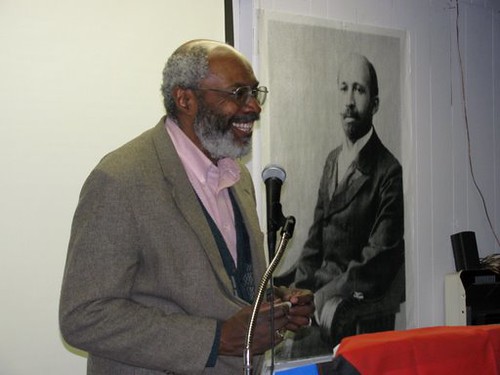
Abayomi Azikiwe, editor of the Pan-African News Wire, addressing the MECAWI forum entitled: "African-Americans Speak Out for Palestine" on January 31, 2009. (Photo: Alan Pollock), a photo by Pan-African News Wire File Photos on Flickr.
Fifty Years Since the Freedom Rides: The Struggle Against Racism and National Oppression
Efforts of students and civil rights advocates changed the course of U.S. history
By Abayomi Azikiwe
Editor, Pan-African News Wire
May 4 represented the 50th anniversary of the beginning of the Freedom Rides, a major civil rights campaign that broke the back of racial segregation in inter-state public travel in the United States. A documentary aired on PBS’s American Experience series on May 16 sparked much discussion on both the historical significance of the civil rights movement as well as the current status of African Americans today.
The documentary featured interviews and archival news footage of the period in 1961 when anyone challenging segregation in the South risked imprisonment, torture and even death. During the course of the sit-ins the previous year in 1960, a broad-based student movement was formed and organized under the banner of the Student Nonviolent Coordinating Committee.
Although the Freedom Rides were started by the Congress of Racial Equality (CORE), a civil rights and pacifist organization formed in 1942, after the bombing of a Greyhound bus on Mother’s Day in 1961 in Anniston, Alabama, CORE abandoned the campaign. However, the activists from SNCC based in Nashville, Tennessee under the leadership of Diane Nash, announced that it was essential that the Freedom Rides continue.
Student activist Lucretia Collins summed up the sentiments within SNCC when she said that “In Nashville, we had been informed that CORE was going to have Freedom Rides that could carry people all over the South and their purpose was to test the facilities at the bus stations in the major cities. Later we heard that a busload of the Freedom Riders had been burned on Mother’s Day in Anniston, Alabama, and that another bus had been attacked by people in Birmingham.” (Taken From “The Making of Black Revolutionaries,” by James Forman, 1972, pp. 145-157)
Collins went on to stress that “CORE was discontinuing the Freedom Rides, people said. We felt that it had to continue even if we had to do it ourselves. We knew we were subject to being killed. This did not matter to us. There was so much at stake, we could not allow segregationists to stop us. We had to continue that Freedom Ride even if we were killed in the process.”
After the continuation of the Freedom Rides by SNCC and their supporters, the federal government under the Kennedy administration was forced to intervene and repeal the segregation laws that regulated inter-state public transportation. This was only done after numerous activists were beaten and tortured as well as imprisoned on false charges in Parchman Correctional Facility in Mississippi, one of the most notorious prisons in the South.
Changing the Course of History
The Freedom Rides, as the sit-ins had done the year before, provided greater momentum for the civil rights movement. After 1961, increased mass mobilizations took place throughout the South beginning in Albany, Georgia in 1962 when an anti-segregation campaign brought out thousands for mass protests and arrests.
In 1963, the civil rights movement would advance even further with mass mobilizations in Birmingham involving thousands of students. These demonstrations against segregation would spread throughout the South as well as the North to cities such as Somerville, Tennessee and Chicago, Illinois.
It was out of the demonstrations during the spring and summer of 1963 that led to the first massive protests of the era in Detroit on June 23 and later in Washington, D.C. with the historic gathering on August 28. The following year the Civil Rights Act of 1964 was passed outlawing racial discrimination inside the United States.
The following year in 1965, after the efforts of the freedom summer of 1964 in Mississippi and other areas and the voting rights campaign in Selma during early 1965, the Voting Rights Act was passed ostensibly guaranteeing universal suffrage in the United States. In 1966, the movement would become more militant when SNCC came out in opposition to the draft and the Vietnam War as well as raising the slogan of Black Power during the “March Against Fear” from Memphis, Tennessee to Jackson, Mississippi in June of that year.
Legacy of the Civil Rights Movement Must Be Revived
Today the ruling class in the United States is waging war against all of the gains of the labor and civil rights struggles of the last 75 years. Public sector workers, educational employees and students are facing massive salary cuts, lay-offs and the outlawing of collective bargaining rights.
Since many of the gains made in the movement’s efforts to eliminate employment and educational discrimination have occurred in the public sector, the attacks on unions representing this segment of the working class take on a decisively racist and sexist character. Consequently, the current fight back movement that emerged in the Wisconsin Capitol occupation of the Winter of 2011 must be viewed within the context of the continuing struggle for civil rights, women’s and national liberation.
Just as it took courage and creativity to breakdown legalized segregation in the U.S., it will take as much if not greater efforts to defeat the ruling class challenges placed before the people in the current period. Consequently, a broad alliance of the nationally oppressed, women and the working class as a whole must come together to take on the austerity measures and repression that is the latest mechanism designed to further the exploitation and oppression of the majority of people in the U.S.
No comments:
Post a Comment